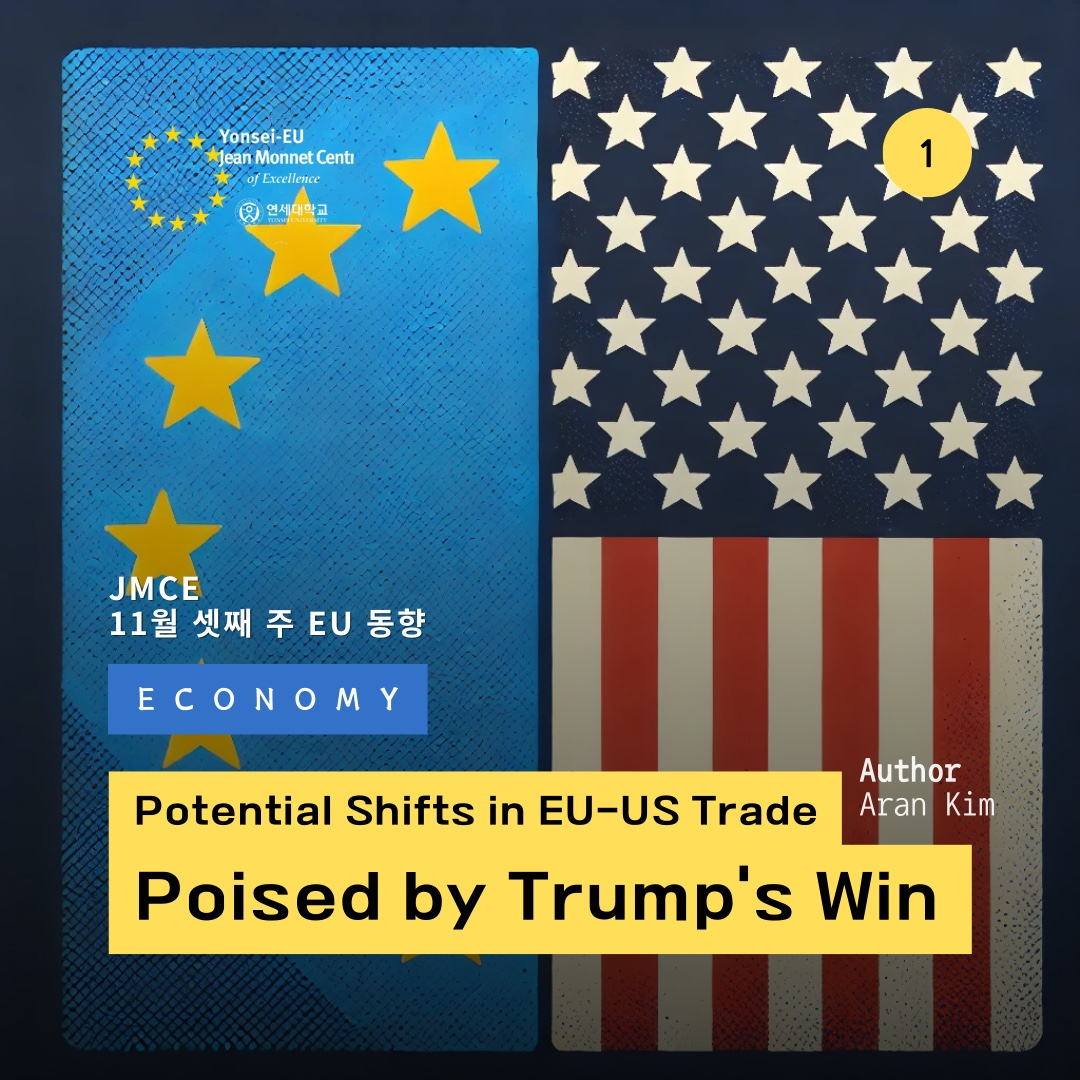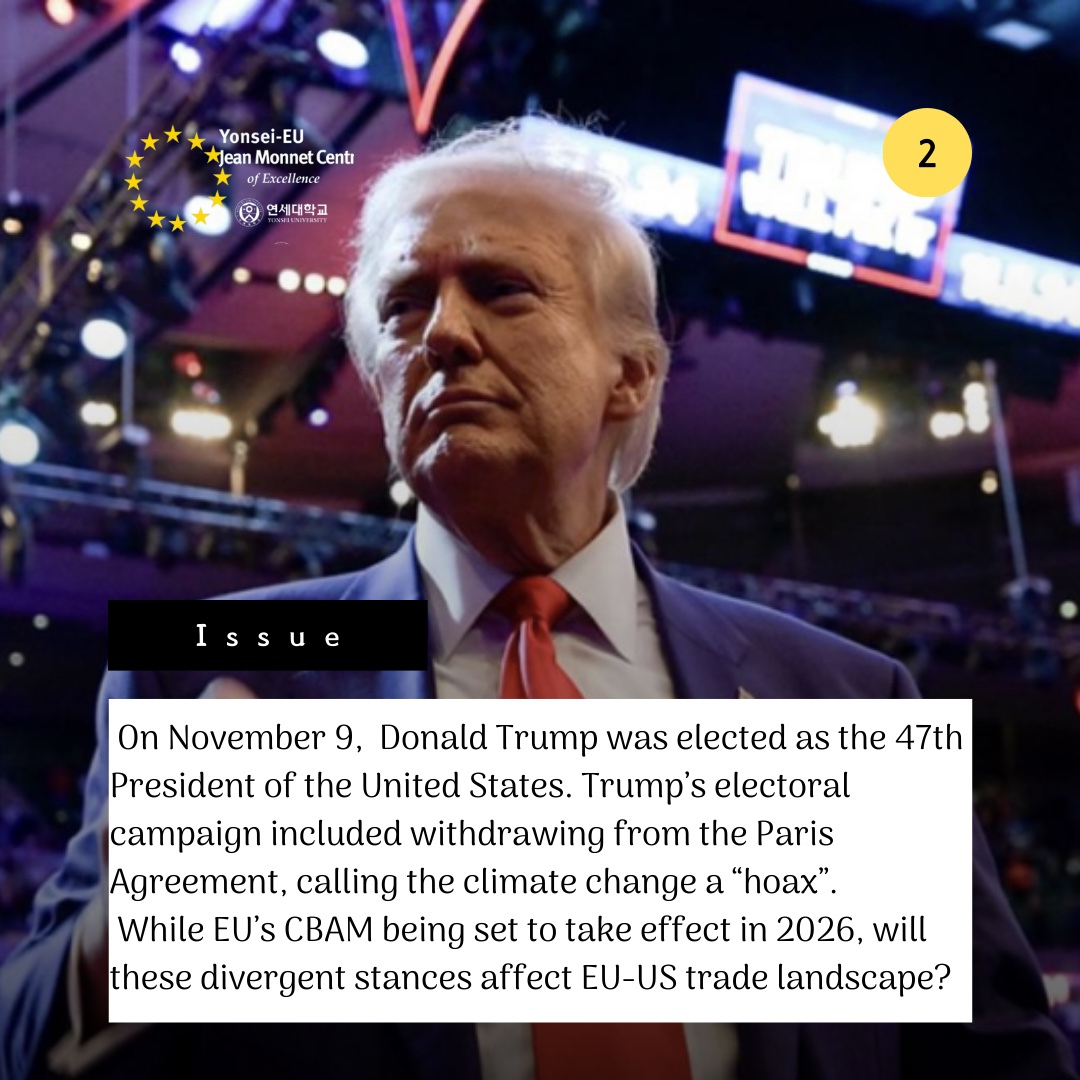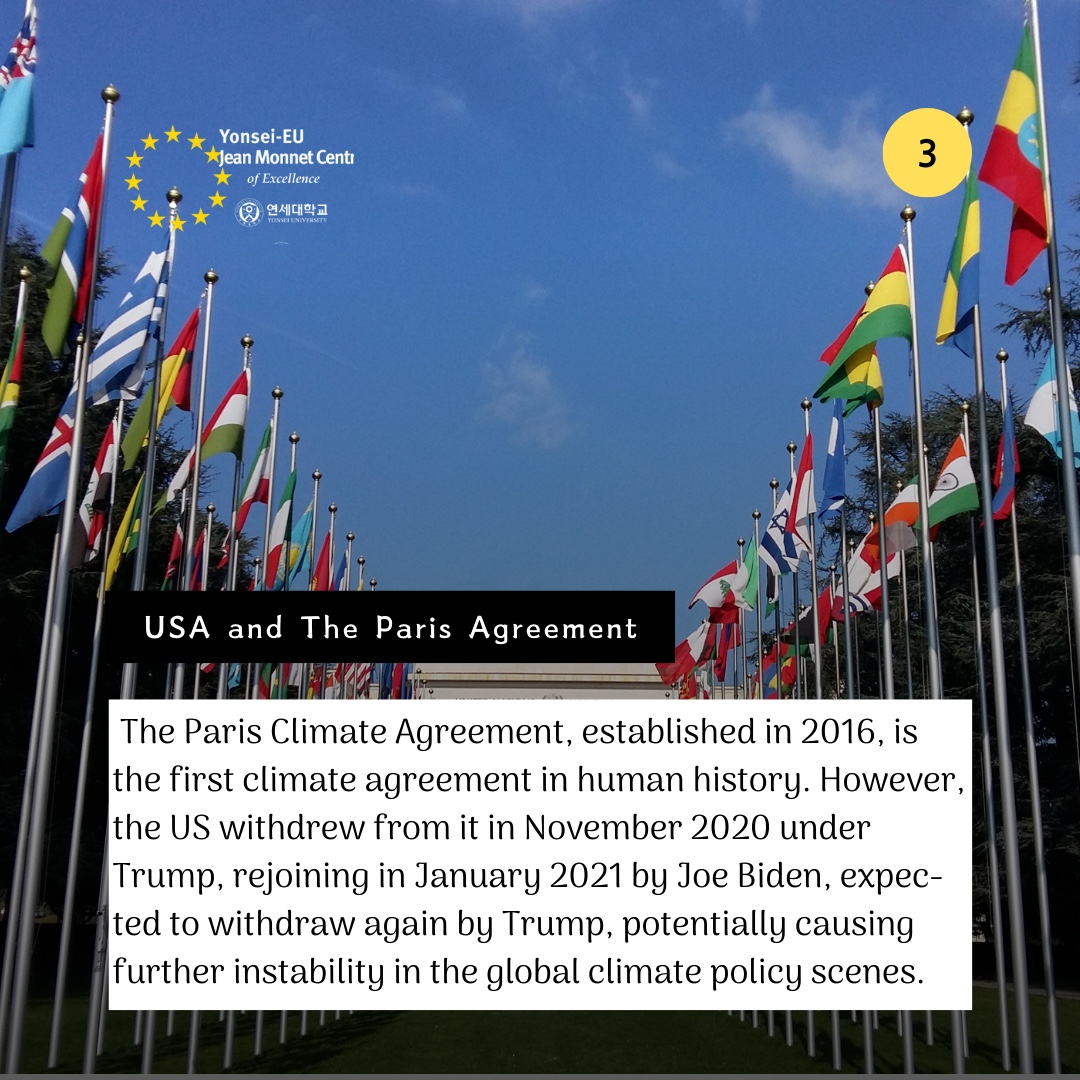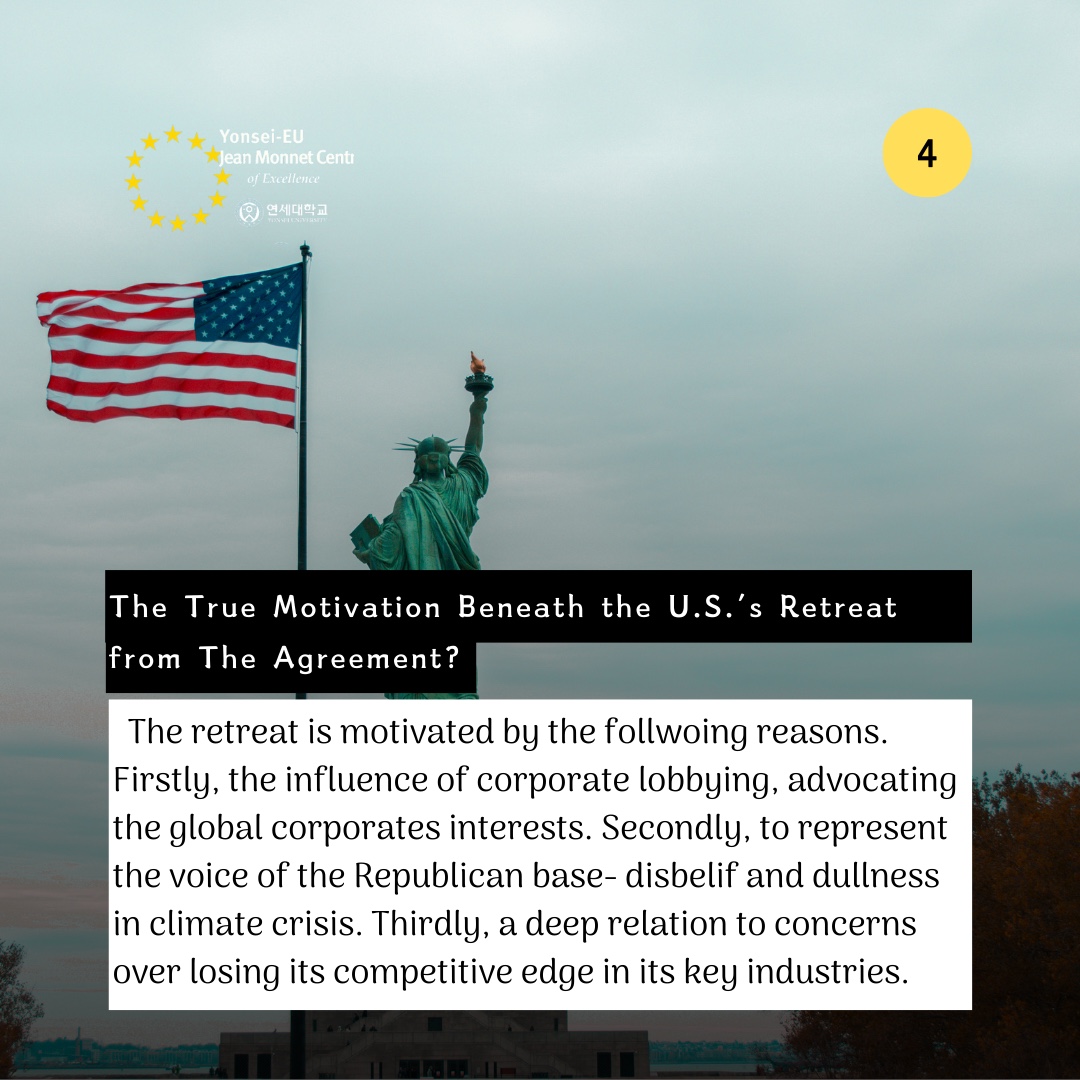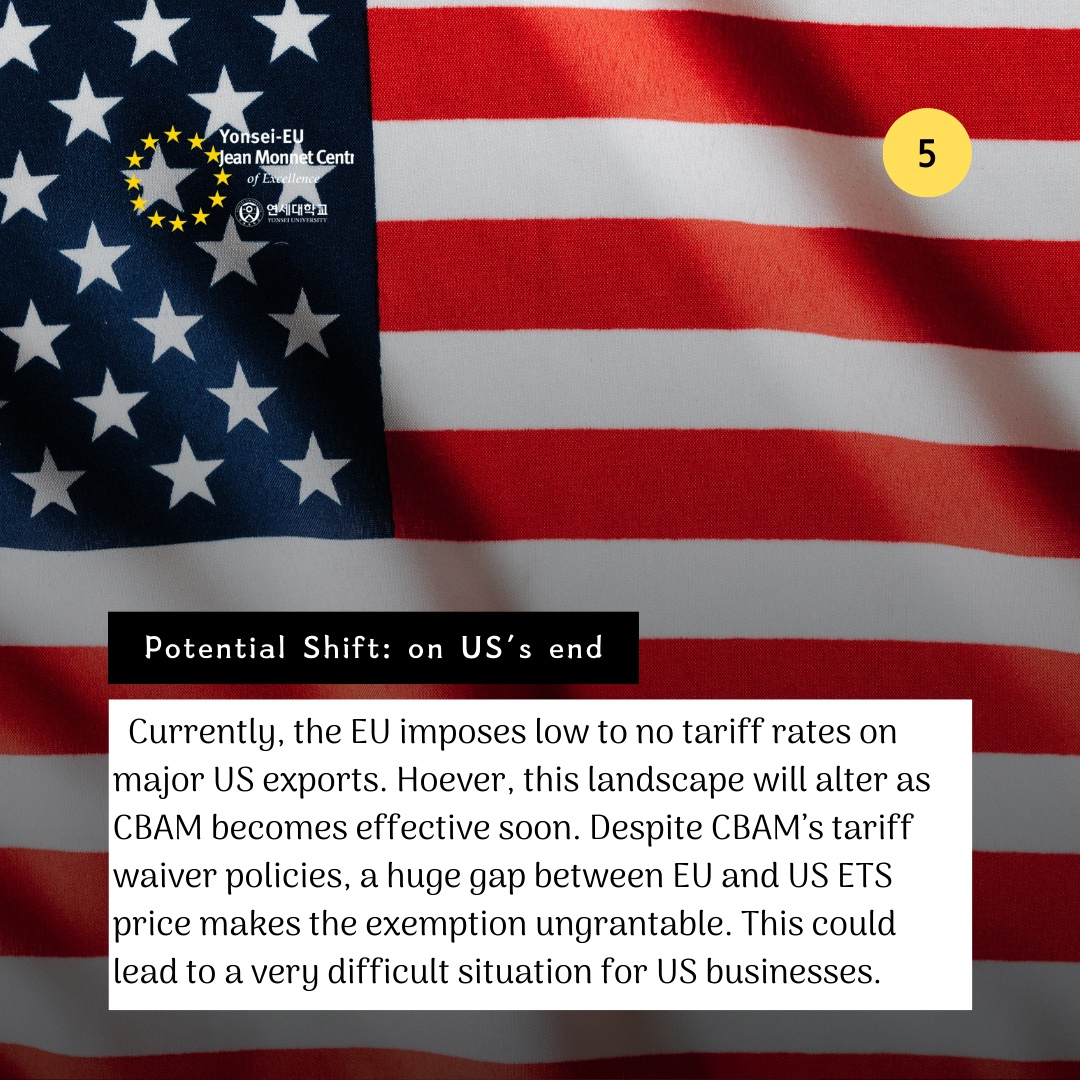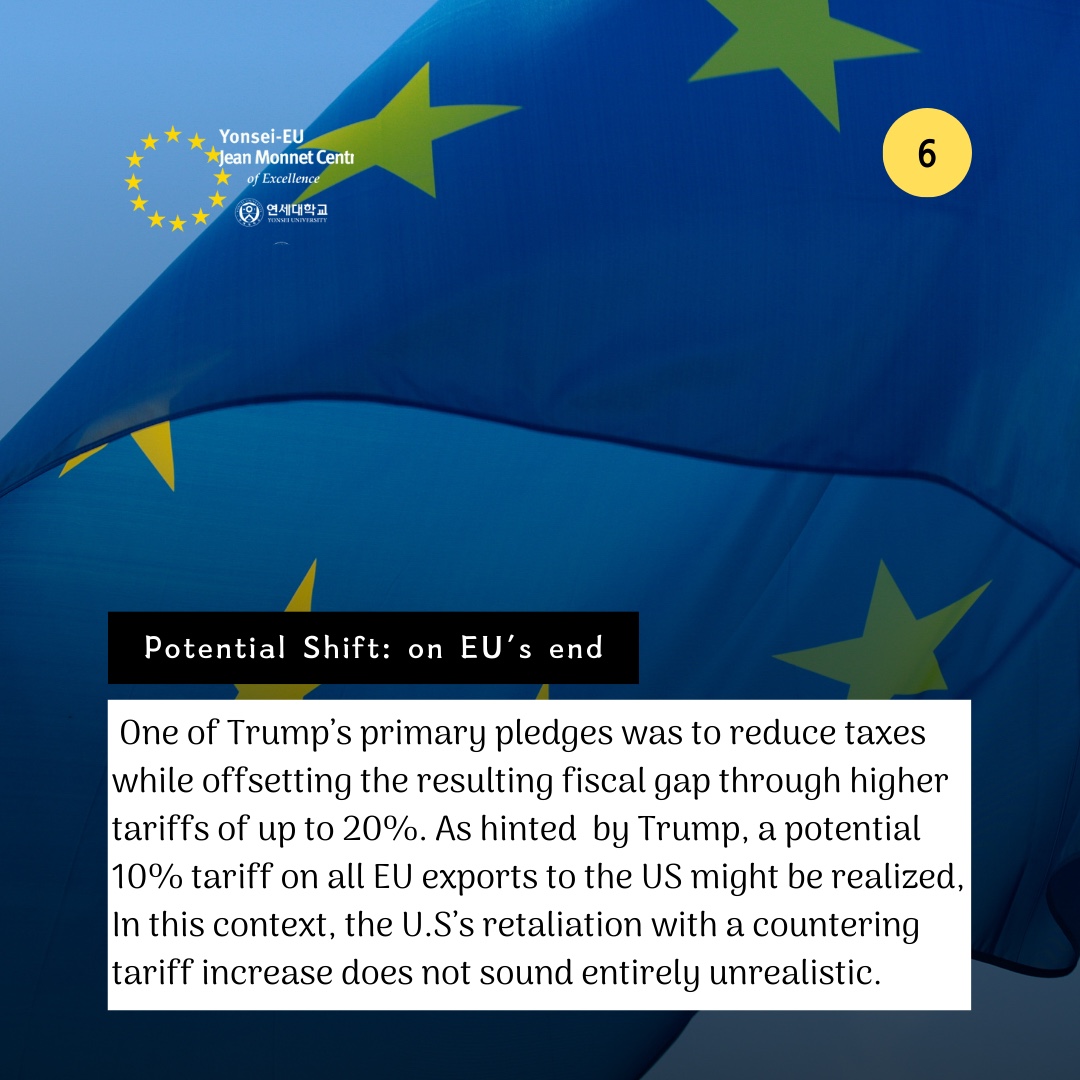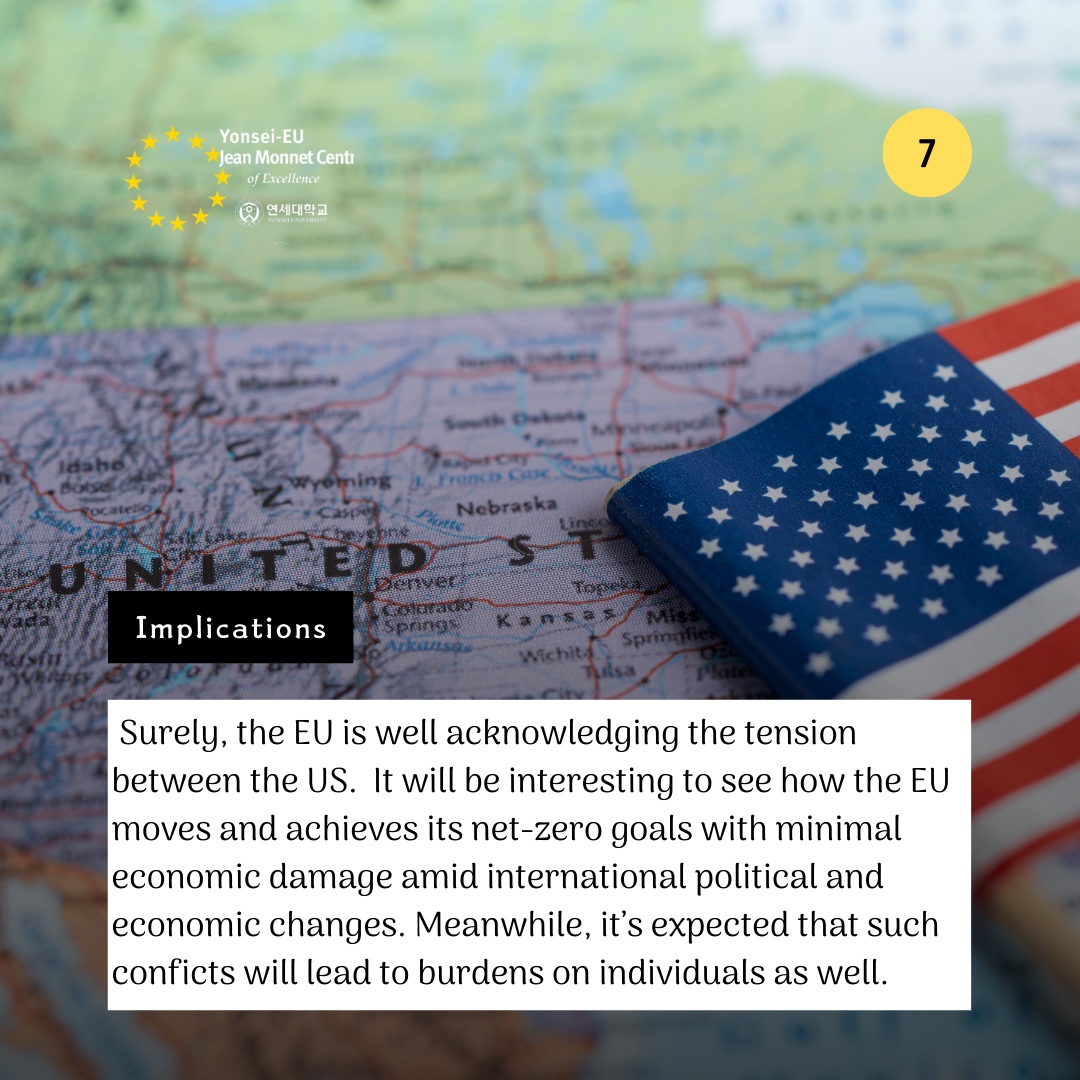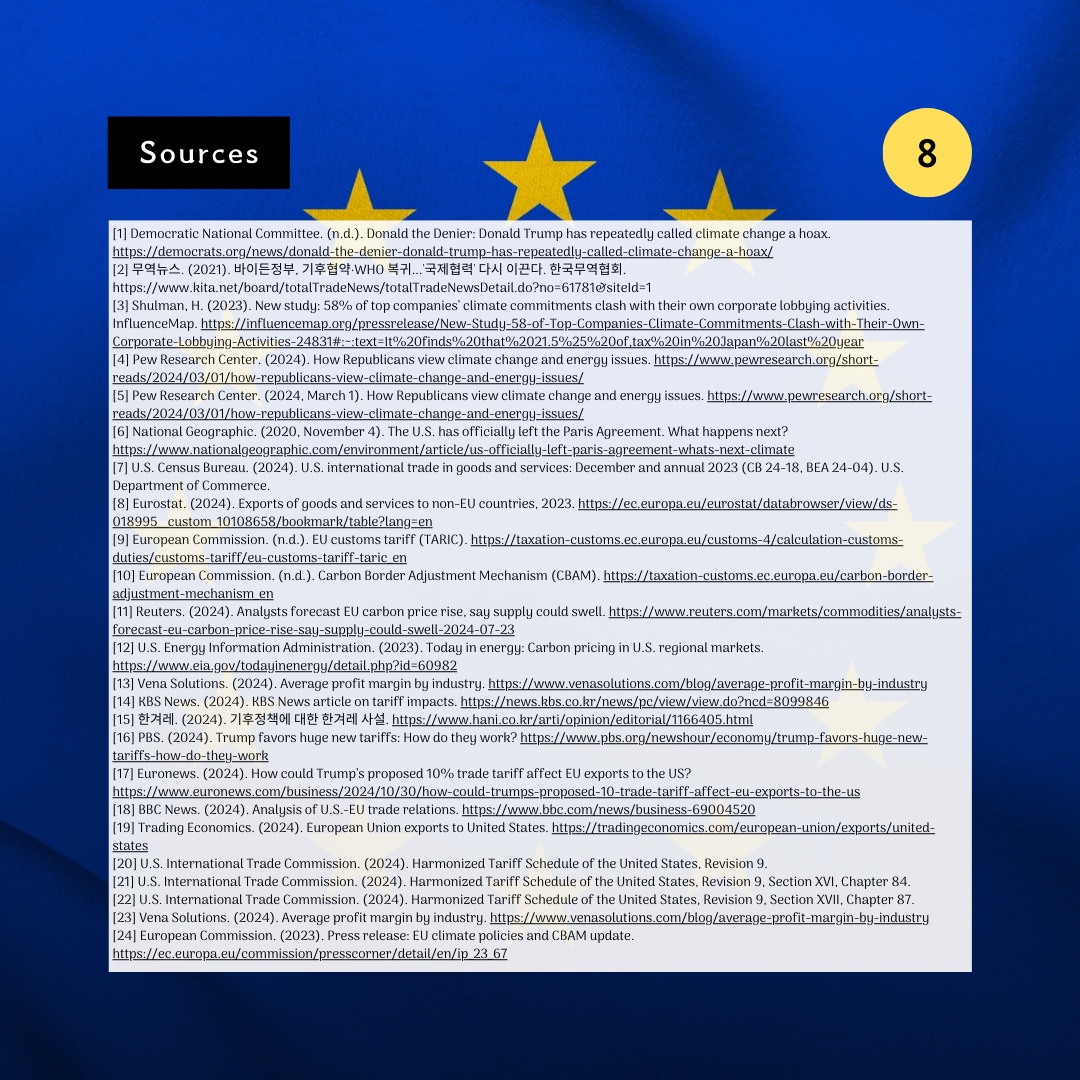YONSEI-EU Jean Monnet Centre
EU와 ASIA를 연결하는 네트워크 허브
EU 동향
EU 관련 최신 현안 이슈 및 동향을 분석하고 시사점을 제시합니다.
Potential Shift in EU-US Trade Poised by Trump’s Win
On November 9, Republican Donald Trump was elected as the 47th President of the United States. He ran on a campaign of ‘MAGA’ (Make America Great Again), which appealed to both conservative and centrist vote. Trump's campaign promises included withdrawing from the Paris Agreement, dismissing the climate change as a “hoax”, and continuing to rely on traditional fossil fuels.[1] Since Europe's CBAM is set to take effect in 2026, the two Western powers, the US and the EU are poised to adopt diametrically opposing market policies. The brief aims to analyze and predict how these divergent stances may affect EU-US trade and transactions.
[USA and The Paris Agreement]
The Paris Climate Agreement, established in 2016, is a landmark accord aimed at collaboratively reducing carbon emissions to combat global warming, making the first comprehensive climate agreement in human history. With only a few nations remaining outside its framework, the US -a global superpower- has been through significant political and societal turmoil and conflicts over its participation. The US withdrew from the Agreement in November 2020 under Donald Trump, rejoining in January 2021 on the day Joe Biden was inaugurated as the 46th president.[2] However, with Donald Trump re-elected, the U.S. is expected to withdraw again, potentially causing further instability and shifts in the global climate policy landscape.
[The True Motivation Beneath the U.S.’s Retreat from the Agreement]
Before examining the potential scenarios in EU-US trade, it is essential to identify the primary causes and motivations behind the U.S.’s opposition to global climate initiatives.
Firstly, the U.S. political system is known to have strong historical ties to corporate lobbying. Major corporations such as Shell and Delta Airline are reported to be at significant risks of greenwashing. For example, Chevron, which has committed to net zero by 2050, has advocated this year to weaken US vehicle tailpipe emissions standards. [3] It stands to reason that catering to the interests of these huge global conglomerates has driven the Republican Party to sideline climate crisis agendas, especially it is presumed that many of their donors are greatly responsible for environmental degradation.
Secondly, positioning themselves as the voice of these constituencies, the Republican Party effectively reinforced its electoral strategy, aligns its climate policies with the views of its base. Of only 23%, among Republican voters, saw climate change as a major threat to the country’s well-being. By contrast, larger majority (78%) of Democrats and Democratic-leaning independents viewed it as a major threat to the U.S. [4] This skepticism of Republicans toward entity of climate crisis and practicality of multilateral frameworks like the Paris Agreement aligns with their broader distrust of global governance.
Thirdly, the U.S.’s retreat from global climate commitments can be deeply related to concerns over economic competitiveness and sovereignty. Many Republicans argue that international climate agreements impose unfair economic burdens on the U.S., potentially leading to job losses in key industries such as energy, manufacturing, and agriculture.[5] By freeing itself from such agreements, the U.S. seeks to prioritize domestic economic growth and maintain its competitive edge, particularly in traditional industries reliant on fossil fuels.[6]
[Potential Shift in EU-US Trade Landscape: on US’s end]
To understand the potential impact of CBAM on the U.S., let’s go through the most transactional sectors within the EU market. The top U.S. exports to the EU in 2023 were: (1) Petroleum oils, crude – $42.37 billion, (2) Medicinal and pharmaceutical products – $32.99 billion, (3) Natural gas, whether or not liquefied – $27.28 billion, (4) Engines and motors, non-electric – $23.84 billion and (5) Aircraft and associated equipment – $19.59 billion.[7][8] Together, these categories account for a total export value of $146.07 billion.
Currently, the EU imposes relatively low to no tariff rates on these products: (1)(2)(3) Petroleum oils, crude, Medicinal and pharmaceutical products, Natural gas, whether or not liquefied – 0% (4) Engines and motors, non-electric – 0~4.2% and (5) Aircraft and associated equipment – 0%.[9] However, being CBAM effective in 2026, sectors with high carbon emissions—such as 4 of these top 5 U.S. exports—are expected to face higher tariffs.
However, CBAM provides the possibility of tariff waivers for countries implementing carbon reduction measures domestically, such as Emissions Trading Systems (ETS).[10] Despite, there still exists a key challenge due to the significant disparity in carbon pricing between the EU and the U.S. In the EU ETS, carbon prices were approximately €62.50 ($66) per ton as of July 2024.[11] Meanwhile, in the U.S., regional carbon markets like the Regional Greenhouse Gas Initiative (RGGI) had an average price of $13.85 per ton as of September 2023.[12] This stark price gap makes it difficult for the EU to justify granting tariff exemptions to U.S. exporters as much as they ask for.
The situation is only anticipated to be further complicated by the Trump administration’s opposing climate agenda. Considering the slim average net profit margins—4.96% for aircraft and spacecraft, 12.40% for oil/gas, and 9.77% for machinery [13]—even moderate tariff increases could erode profitability
. The additional costs would not only impact on these key industries but could also ripple across other carbon-intensive sectors, leaving little room for choice but to adjust to greener business practices.
[Potential Shift in EU-US Trade Landscape: on EU’s end]
The newly elected President of the United States has officially and repeatedly announced his conviction to raise tariffs of up to 60% on Chinese exports.[14] He has also warned that the U.S. will no longer engage in trade agreements that result in economic losses, signaling a considerable shift from a free trade framework to a more protectionist trade era.[15]
Furthermore, one of Trump’s primary pledges was to reduce taxes while offsetting the resulting fiscal gap through higher tariffs of up to 20% on items that the U.S. does not import in great quantities.[16] Consequently, a transformation in the country’s customs and tariff system appears inevitable. Backing up, a potential 10% tariff on all EU exports to the US might be realized, as it was a key proposal from Trump Party in his 2024 re-election.[17]
In this context, the U.S. may retaliate with a countering tariff increase targeting EU goods. Especially with the examples set by former President Joe Biden, which hit Chinese electric cars with a jaw-dropping soar in tariffs from 25% to 100%, the concern does not sound entirely unrealistic.[18]
The top 3 goods exported from the EU to the U.S. in 2022 include: (1) Pharmaceutical products worth $91.96 billion, (2) Machinery, nuclear reactors, and boilers worth $83.92 billion, and (3) Vehicles other than railway and tramway worth $53.93 billion.[19] The current U.S. tariff rates on these items vary depending on the specific products and quantities but generally fall within the following ranges: (1) pharmaceutical products – 0%, (2) machinery – 0% to 6.7%, and (3) vehicles – 1.7%.[20][21][22]
If tariffs were to increase by just 5%, the additional tariff imposed on each category would amount to approximately (1) $4.59 billion, (2) $4.19 billion, and (3) $2.69 billion, respectively. While variations exist depending on the industry and company size, considering that the net profit margins for each sector are approximately 15.2%, 9.77%, and 3.53% [23], even a 5% tariff increase could significantly erode corporate margins, triggering a domino effect on operational practices.
For example, EU manufacturers might respond by reducing their workforce, adopting cheaper labor—such as migrant workers—or shifting production to low-income countries through OEM arrangements, contributing to another carbon colonialism issue. This could lead to structural changes across the European and global industrial landscape.
Surely, the EU is well acknowledging the tension between the US. In fact, in December 2023, the EU decided to prolong the suspension on tariffs on steel and aluminum imports from the U.S. [24] This was deemed as a responsive gesture to the U.S. 'Section 232' steel and aluminum tariffs.
With the US under Trump's leadership for the next 4 years, experts will need to closely observe how the US reshapes international policies. If a tariff war materializes, as the Trump administration has hinted, international stakeholders will need to be vigilant and proactive to mitigate economic damage and protect their own interests alongside the quick adaptation to the changes.
In particular, the European Union -global leader in green initiatives- will face challenges during these US policy and political alterations. It will be interesting to see how the EU moves and achieves its net-zero goals with minimal economic damage amid international political and economic changes.
Meanwhile, these additional costs will be passed on to consumers and small and medium-sized enterprises (SMEs) within the organic system by increasing the production costs of products and changing supply chain strategies, leading to burdens on an individual level.
kimeunjeong387728@gmail.com
[1] Democratic National Committee. (n.d.). Donald the Denier: Donald Trump has repeatedly called climate change a hoax. https://democrats.org/news/donald-the-denier-donald-trump-has-repeatedly-called-climate-change-a-hoax/
[2] 무역뉴스. (2021). 바이든정부, 기후협약·WHO 복귀...'국제협력' 다시 이끈다. 한국무역협회. https://www.kita.net/board/totalTradeNews/totalTradeNewsDetail.do?no=61781&siteId=1
[3] Shulman, H. (2023). New study: 58% of top companies’ climate commitments clash with their own corporate lobbying activities. InfluenceMap. https://influencemap.org/pressrelease/New-Study-58-of-Top-Companies-Climate-Commitments-Clash-with-Their-Own-Corporate-Lobbying-Activities-24831#:~:text=It%20finds%20that%2021.5%25%20of,tax%20in%20Japan%20last%20year
[4] Pew Research Center. (2024). How Republicans view climate change and energy issues. https://www.pewresearch.org/short-reads/2024/03/01/how-republicans-view-climate-change-and-energy-issues/
[5] Pew Research Center. (2024, March 1). How Republicans view climate change and energy issues. https://www.pewresearch.org/short-reads/2024/03/01/how-republicans-view-climate-change-and-energy-issues/
[6] National Geographic. (2020, November 4). The U.S. has officially left the Paris Agreement. What happens next? https://www.nationalgeographic.com/environment/article/us-officially-left-paris-agreement-whats-next-climate
[7] U.S. Census Bureau. (2024). U.S. international trade in goods and services: December and annual 2023 (CB 24-18, BEA 24-04). U.S. Department of Commerce.
[8] Eurostat. (2024). Exports of goods and services to non-EU countries, 2023. https://ec.europa.eu/eurostat/databrowser/view/ds-018995__custom_10108658/bookmark/table?lang=en
[9] European Commission. (n.d.). EU customs tariff (TARIC). https://taxation-customs.ec.europa.eu/customs-4/calculation-customs-duties/customs-tariff/eu-customs-tariff-taric_en
[10] European Commission. (n.d.). Carbon Border Adjustment Mechanism (CBAM). https://taxation-customs.ec.europa.eu/carbon-border-adjustment-mechanism_en
[11] Reuters. (2024). Analysts forecast EU carbon price rise, say supply could swell. https://www.reuters.com/markets/commodities/analysts-forecast-eu-carbon-price-rise-say-supply-could-swell-2024-07-23
[12] U.S. Energy Information Administration. (2023). Today in energy: Carbon pricing in U.S. regional markets. https://www.eia.gov/todayinenergy/detail.php?id=60982
[13] Vena Solutions. (2024). Average profit margin by industry. https://www.venasolutions.com/blog/average-profit-margin-by-industry
[14] KBS News. (2024). KBS News article on tariff impacts. https://news.kbs.co.kr/news/pc/view/view.do?ncd=8099846
[15] 한겨레. (2024). 기후정책에 대한 한겨레 사설. https://www.hani.co.kr/arti/opinion/editorial/1166405.html
[16] PBS. (2024). Trump favors huge new tariffs: How do they work? https://www.pbs.org/newshour/economy/trump-favors-huge-new-tariffs-how-do-they-work
[17] Euronews. (2024). How could Trump’s proposed 10% trade tariff affect EU exports to the US? https://www.euronews.com/business/2024/10/30/how-could-trumps-proposed-10-trade-tariff-affect-eu-exports-to-the-us
[18] BBC News. (2024). Analysis of U.S.-EU trade relations. https://www.bbc.com/news/business-69004520
[19] Trading Economics. (2024). European Union exports to United States. https://tradingeconomics.com/european-union/exports/united-states
[20] U.S. International Trade Commission. (2024). Harmonized Tariff Schedule of the United States, Revision 9.
[21] U.S. International Trade Commission. (2024). Harmonized Tariff Schedule of the United States, Revision 9, Section XVI, Chapter 84.
[22] U.S. International Trade Commission. (2024). Harmonized Tariff Schedule of the United States, Revision 9, Section XVII, Chapter 87.
[23] Vena Solutions. (2024). Average profit margin by industry. https://www.venasolutions.com/blog/average-profit-margin-by-industry
[24] European Commission. (2023). Press release: EU climate policies and CBAM update. https://ec.europa.eu/commission/presscorner/detail/en/ip_23_671
